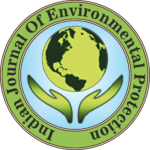IJEP 41(12): 1386-1390 : Vol. 41 Issue. 12 (December 2021)
Animesh Agarwal*, Nitin Kumar Agrawal and Harendra Kumar
Moradabad Institute of Technology, Department of Applied Sciences and Humanities, Moradabad-244 001, U.P., India
Abstract
In the present work treated dhoopbatti (incense stick) ash (TDA) is used as an adsorbent for the removal of copper from its aqueous solution. The adsorbent is a waste material left after worship of Hindu God; it is easily available in Hindu temples. The effect of contact time, initial concentration, adsorbent dose and pH were studied on the removal percentage of metal ions. The TDA is first time used as adsorbent and found to have good adsorption properties. Cu(II) adsorption was maximum at pH 3 and it was also observed that as the pH increases, the adsorption began to decrease. It was observed during study that removal of copper decreases with increase in initial concentration. The SEM image and FTIR spectra of TDA clearly shows that various functional groups are attached in TDA which enhances the adsorption capacity of adsorbent. The Langmuir isotherm was also applied during present study which shows monolayer adsorption.
Keywords
Adsorption, Dhoopbatti, adsorbent, Langmuir isotherm
References
- Iqbal, M. and R.G.J. Edyvean. 2004. Biosorption of lead, copper and zinc ions on loofa immobilized biomass of Phanerochaete chrysosporiu. Minerals Eng., 17:217-223.
- Iqbal, M. and R.G.J. Edgvean. 2005. Loofa sponge immobilized fungal biosorbent : A robust system for cadmium and other dissolved metal removal from aqueous solution. Chemosphere. 61:510-518.
- Agarwal, A. and M. Saxena. 2011. Assessment of toxic effect of industrial effluent on aquatic life in river Gagan at Moradabad, India. Der. Chemica Sinica., 2(2):172-176.
- Fabianil, C., et al. 1996. Chromium (III) salts recovery process from tannery wastewater. Desalination. 108:183.
- Brooks, C.S. 1991. Metal recovery from industrial waste. Lewis Publisher, U.S.A.
- Tiravanti, G., D. Petruzzeli and R. Passino. 1997. Pretreatment of tannery wastewaters by an ion exchange process for Cr (III) removal and recovery. Water Sci. Tech., 36:197-207.
- Sari, A., M. Tuzen and M. Soylak. 2007. Adsorption of Pb(II) and Cr(III) from aqueous solution on celtic clay. J. Hazard. Mater., 144:41-46.
- Song, Z., C.J. Williams and R.G.J. Edyvean. 2000. Sedimentation of tannery wastewater. Water Res., 34:2171-2176.
- Shukla, A., et al. 2002. The role of sawdust in the removal of unwanted materials from water. J. Hazard. Mater., B95:137-152.
- Pappalardo, L., F. Jumean and N. Abdo. 2010. Removal of cadmium, copper, lead and nickel from aqueous solution by white, yellow and red united Arab Emirates sand. American J. Env. Sci., 6(1):41-44.
- Yusoff, S.N.M., et al. 2014. Removal of Cu (II) and Zn (II) ions from aqueous solutions using selected agricultural wastes : Adsorption and characte-rization studies. J. Env. Prot., 5(5):289-300.
- Krishna, R.H. and A.V.V.S. Swamy. 2011. Studies on the removal of Ni (II) from aqueous solutions using powder of mosambi fruit peelings as a low cost adsorbent. Chem. Sci. J., 1-11.
- Singh, V. K., et al. 2010. Removal of malathion from aqueous solutions and wastewater using flyash. J. Water Resour. Prot., 2:322-330.
- Gupta, V. K., et al. 2003. Removal of cadmium and nickel from wastewater using bagasse flyash-A sugar industry waste. Water Res., 37:4038-4044.
- Awan, M. A., et al. 2003. Removal of heavy metals through adsorption using sand. J. Env. Sci., 15(3): 413-416.
